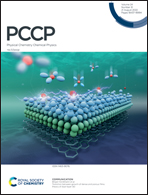Spin engineering of triangulenes and application for nano nonlinear optical materials design†
Abstract
The recently synthesized triangulenes with non-bonding edge states could have broad potential applications in magnetics, spintronics and electro-optics if they have appropriate electronic structure modulation. In the present work, strategies based on molecular orbital theory through heteroatom doping are proposed to redistribute, reduce or eliminate the spin of triangulenes for novel functional materials design, and the role of B, N, NBN, and BNB in such intended electronic structure manipulation is scrutinized. π-Extended triangulenes with tunable electronic properties could be potential nonlinear optical (NLO) materials with appropriate inhibition of their polyradical nature. The elimination of spin is achieved by B, N, NBN, and BNB doping with the intended geometric arrangement for enhanced polarity. Intended doping of BNB results in an optimal structure with large static first hyperpolarizability (〈β0〉) as well as strong Hyper–Rayleigh scattering (HRS) βHRS(−2ω; ω, ω) (ω = 1064.0 nm), TG7-BNB-ba with a large 〈β0〉 (18.85 × 10−30 esu per heavy atom) and βHRS (1.15 × 10−28 esu per heavy atom) much larger than that of a synthesized triangular molecule (1.12 × 10−30 esu of 〈β0〉 per heavy atom and 5.04 × 10−30 esu of βHRS per heavy atom). The strong second order NLO responses in the near-infrared and visible regions, particularly the strong sum frequency generation, make these B or (and) N doped triangulenes promising candidates for the fabrication of novel carbon-based optoelectronic devices and micro-NLO devices.

- This article is part of the themed collection: 2022 PCCP HOT Articles


 Please wait while we load your content...
Please wait while we load your content...